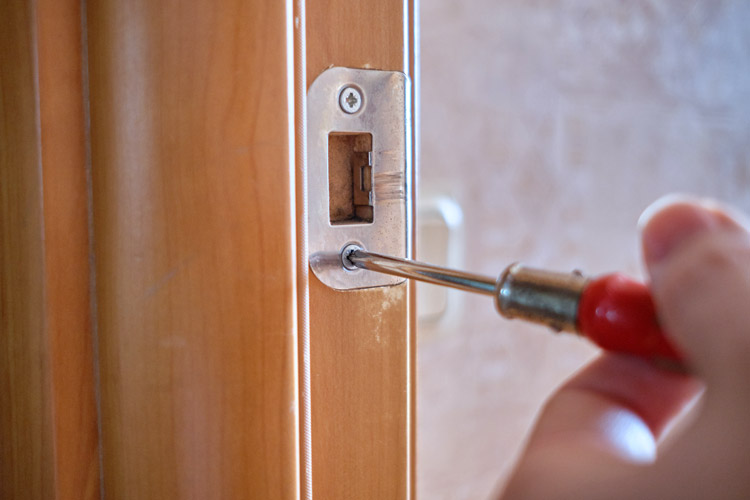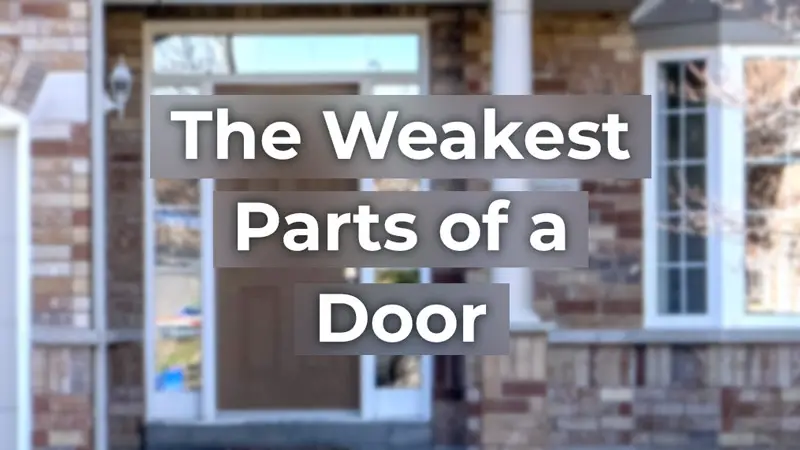Whether you want to reinforce and secure, or kick down your own door for any reason, you must know its weakest parts.
However, being aware of the weak spots is only half of the story. You’ll get the most benefits from understanding the real reasons behind the vulnerabilities.
And that’s what this article is about.
The weakest parts of a door are typically the hinges, the strike plate and the mounting screws, and the lock itself. Moreover, doors with a larger glass surface and doors without a solid core are especially vulnerable to force attacks.
Now let’s see the weak spots, one by one.
1. Hinges

When it comes to hinges, outward-opening doors are way more vulnerable than inswing doors. Especially if they’re secured with standard butt hinges.
The reason is that doors that open outward have the hinges exposed all the time, so anyone (including criminals) has access to them from the outside.
What is the weakest part of a door hinge?
Removable hinge pins are a real security concern (mainly for doors opening inwards) because if they’re not in place, the door can easily be removed from its place.
Once the hinge pins are removed, there’s nothing that secures the door to the jamb.
In fact, if you have an outswing door, removing the pins is quick and simple, so an experienced burglar can get inside in seconds without any real effort.
Most modern inward-opening pre-hung doors (ready to go doors) are equipped with relatively secure hinges. If that is what you have, your door’s weakest point is probably not the hinges and you need to take a closer look at the strike plate (next section).
Quick Fixes
An easy way to fix this weak point is to replace your existing hinges with security hinges.
Security hinges are designed to prevent the door from being removed, or at least to make the process much harder. They come with non-removable pins and they often feature other security solutions as well, such as studs or removable set screws.
If you have some basic tools at home, such as a power drill and hammer, you can add studs to your existing hinges by yourself. Find more information on how to secure hinges in this article.
If you need to secure an outward-opening door, this is the article you want to read.
If you want to replace your existing hinges, you can find the most secure and strongest types of hinges in this article.
2. Weak Strike Plate and Short Mounting Screws

The strike plate is an extremely common weak spot of many doors. Think of it: this small plate and the mortise underneath are holding the bolt and keeping one complete side of the door in place.
The security of the entire door depends on the strike plate to a great extent.
So what are the possible issues with the door strike?
One common problem is that the mounting screws are too short. As these screws secure the strike to the door frame, the shorter they are, the fewer force attacks the door will withstand.
Standard strike plates are installed over a mortise, however, they’re just flat plates and they don’t fill the whole mortise. That’s another vulnerability.
Some strikes are made of thin, flimsy material that breaks pretty easily. While this is the least common issue, you must pay attention to quality as that can undermine your efforts.
Related: 11 Best Ways to Improve Front Door Security
Quick Fixes
To eliminate this weak point one simple yet powerful tweak is to replace the existing screws with new ones that are at least 3 inches long.
Another improvement you can do is to install a strike box plate underneath or instead of the existing strike. It differs from the standard strike plate in that it has a metal box part that fills the mortise. The deadbolt extends into this box, therefore it’s surrounded by metal instead of wood, which is a much more secure configuration.
Also, always make sure you choose a high-quality product from a trusted manufacturer as it will cost only a few bucks more but will have a great impact on security.
If you want to take home security to the next level, you can install a professional door reinforcement kit, such as Door Armor from Armor Concepts. That will help you protect the hinges and the jamb as well.
Read more on how to reinforce your door to prevent kick-ins.
3. The Lock
The lock can make or break door security as it can be either the strongest or the weakest part of your door, depending on the model you use. Doors without a secure deadbolt lock are easy targets for burglars.
How do you recognize a secure door lock?
First, it has an ANSI Grade 1 certification which means the lock comes with the highest level of security features. For example, a Grade 1 lock can withstand 10 blows with a ram (75 ft⋅lbf) onto the cylinder, while a Grade 2 model can only withstand half of that.
Usually, there’s not much difference in price between an ANSI Grade 1 and Grade 2 door lock, so make sure you choose a Grade 1 model.
Another feature you should look for is an anti-drill design. This means the cylinder and the pins inside the cylinder are made of a material that is much more resistant to force attacks, such as drilling, than the ones inside standard locks. Here’s a brief description and demonstration of the parts of a pin tumbler lock.
If you have the budget, I also highly recommend that you opt for a door lock that’s protected against picking and bumping. These are quite typical ways of gaining entry among more sophisticated burglars and they hardly leave any trace. Using a pick-resistant and bump-proof lock will prevent criminals from taking advantage of these weaknesses.
4. Glass

While it’s true that burglars prefer not to break glass, however, if that seems to be the most effective way to gain entry, in most cases they won’t hesitate.
If you have a door with glass or sidelights, you often need to take extra security measures to protect your door.
Larger glass surfaces or glass near the lock are considered to be weak areas and can be particularly problematic regarding security.
Unprotected glass is relatively easy to break regardless of how secure the other parts of your door are. This is one reason why a sliding glass door is often the weakest point of a home. The other reason usually has to do with the locking mechanism. Here’s how you can secure a sliding door.
Fixes
The most secure way to protect door glass is by installing either security screens or bars. The drawback is the cost and the altered appearance.
Installing security film can be a reasonable alternative to the previous method as this does not change how the door looks.
A quick way to improve security is to add a glass break sensor to your home. A single device is usually enough as many models have a range of more than 15 feet.
You can find more ways to secure a door with windows in this article.
How to Kick Down a Door
If you need to kick open a door because of an emergency, the first step is to assess if the door is inswing or outswing.
Keep in mind that if you don’t use the right technique or assess the door improperly, you could get hurt (and even break your leg).
If the hinges are on the outside and the knob needs to be pulled to open the door from the outside, you’re dealing with an outward-opening door. You can’t really kick in this type of door. The weakest part of an outswing door is usually the hinges. If you can remove the pins, you’re good to go.
When it comes to inward opening doors, you should check all the above-mentioned potential weak points and assess if the actual door has any weak spots. Reinforced jambs and visible metal shields make it substantially harder to kick down a door.
The best place to kick a door in is right next to the knob. Make sure there’s enough space between you and the door and then give the door a firm kick with your dominant leg. Never kick the knob itself.
Here’s a short demonstration:











